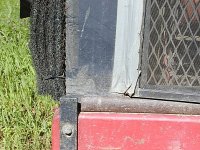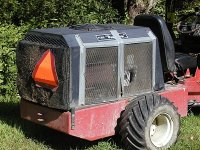Charlie_Iliff
Veteran Member
- Joined
- Jun 13, 2001
- Messages
- 1,896
- Location
- Arnold, MD
- Tractor
- Power Trac PT1845, John Deere 2240, John Deere 950, John Deere 755, Jacobsen Turf Cat II
I can't tell anything from the drawing, but I understand the explanation. A taller oil radiator with bigger openings would let more through, and go longer between cleanings, but I think would still clog, at times.
When I first had the heating problem, I was irritated, as each of you has been. Once I taped screen wire over all expanded metal on the engine compartment, however, it is just a matter of paying attention to sweeping the chaff off the screen every hour or so and thoroughly cleaning the oil radiator before going out. That takes 10 minutes -- 20 if I take the deflector off and wash it out.
Last weekend, I mowed 10 acres of very heavy growth with considerable chaff, at ambient temperature over 90 the whole time. I never got an alarm.
On my old Jacobsen front mower, I had to clean the air filter nearly as often. It is unavoidable on a front mower, but a worthwhile tradeoff for seeing what you're cutting.
Altavista, I understand your frustration, but have you tried the screen wire? It is also really important to take off the top deflector and use a light to make sure you get the radiator really clean. I was astonished how much clogging there still was even after blowing it out. Once I got it really clean, however, with air followed by soap and water, I have been able to keep it working so that I've never interrupted a day's work to do more than brush off the chaff directly in line with the intake. By paying attention, I can mow in as hot weather as I can stand, with the needle steady at about 220.
After looking at filter systems on high-end equipment, I bought a centrifugal dust filter, but have never fabricated the mount. Some day I'll do it. That fix is a lot cheaper than a $1,000 radiator, but a lot more than a layer of screen, Combines, big hay mowers, etc. often use elaborate filter systems, and a lot of tractors have a fine filter ahead of the radiator, even for rear-mounted equipment. We're not alone.
When I first had the heating problem, I was irritated, as each of you has been. Once I taped screen wire over all expanded metal on the engine compartment, however, it is just a matter of paying attention to sweeping the chaff off the screen every hour or so and thoroughly cleaning the oil radiator before going out. That takes 10 minutes -- 20 if I take the deflector off and wash it out.
Last weekend, I mowed 10 acres of very heavy growth with considerable chaff, at ambient temperature over 90 the whole time. I never got an alarm.
On my old Jacobsen front mower, I had to clean the air filter nearly as often. It is unavoidable on a front mower, but a worthwhile tradeoff for seeing what you're cutting.
Altavista, I understand your frustration, but have you tried the screen wire? It is also really important to take off the top deflector and use a light to make sure you get the radiator really clean. I was astonished how much clogging there still was even after blowing it out. Once I got it really clean, however, with air followed by soap and water, I have been able to keep it working so that I've never interrupted a day's work to do more than brush off the chaff directly in line with the intake. By paying attention, I can mow in as hot weather as I can stand, with the needle steady at about 220.
After looking at filter systems on high-end equipment, I bought a centrifugal dust filter, but have never fabricated the mount. Some day I'll do it. That fix is a lot cheaper than a $1,000 radiator, but a lot more than a layer of screen, Combines, big hay mowers, etc. often use elaborate filter systems, and a lot of tractors have a fine filter ahead of the radiator, even for rear-mounted equipment. We're not alone.

